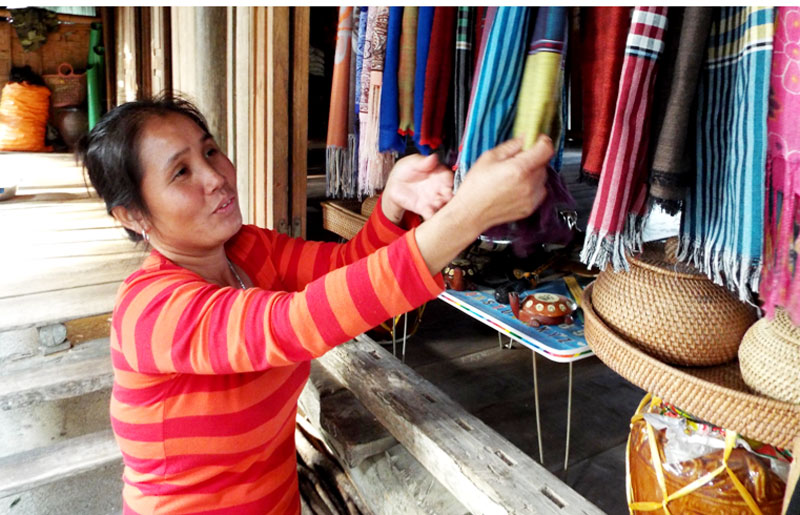
HBO – Giang Mo village in Binh Thanh commune (Cao Phong district) has been become an outstanding Muong cultural highlight for years. Separating from smoke and noise of urban areas, the picturesque romantic vista of Giang Mo is an ideal destination for those who want to find tranquility. Furthermore, this is one of the ethnic-inhabitedvillages which is defined by the provincial tourism sector to become a spearhead product to attract visitors when talking about Hoa Binh.

Brocade products made by
Giang
Molocals are displayed to sell for tourists
Peaceful
Giang
Mo village
is located in the foot of Mo Mountain, about 12km from Hoa Binh city’s downtown.
It is not difficult to reach the village. The village is home to 145 households
who all belong to the Muong ethnic group. It is considered an alive
museum of
Muong ethnics’ traditional culture as
there remains the traditional architecture of stilt houses, looms of Muong
ethnics, and work tools such as rice mortars, bows, cross-bows, and tools for
mountain field works.
Visiting Giang Mo today,
tourists can walk on the small path running throughout the village, contemplate
the untouched beauty of the nature, and can stop at any stilt house to learn
about Muong culture, enjoy bamboo pole dances beside jars of ruou can (a kind
of wine drunk out of a jar through pipes), and experience daily work of locals
such as caring for poultry and cattle, doing field work, hunting for animals
and picking fruits.
Visitors are also offered a
chance to listen to Muong young women’s stories about weaving and traditional brocade
products such as clothes, bags and scarves and enjoy Muong people’s dishes such
as steamed sticky rice, pork, hill vegetables and spring fish.
At this time, visitors can
also enjoy fresh air and smell the fragrance of rice which is being harvested.
Tran Quang Minh, a second-year student of the
Universityof
Culture said: "My classmates
decided to choose
Giang
Mo to visit. This tour helps us understand
more about the life and daily activities of Muong ethnics and have interesting
first-ever experience such as weaving brocade, throwing "con” (a
cloth ball) through a ring or shooting with a crossbow with local children. We
have noteworthy memories in this beautiful village”.
Village head Nguyen Van
Hau said: "
Giang
Mo village
welcomes thousands of visitors, from inside and outside the country each year.
We are trying to increase the quality of services to make tourists comfortable.
We pay attention to keeping everything clean, from houses, alleys to bedding.
Specially, the village controls locals’ insistence on buying goods”.
All these things create typical
features of
Giang
Mo village. Therefore, although
Giang
Mois not an impressive ecological tourist site with specular natural landscapes
or a services tourist attraction with professional products, it gently attracts
visitors with its plain beauty and the heartiness of local residents./.
Located just a 20-minute drive from Hoa Binh City, Ora Hill Farmstay & Glamping Hoa Binh is a captivating new destination nestled in Mo hamlet, Bình Thanh commune, Cao Phong district. Combining farming with leisure, this tranquil retreat is perfect for those seeking balance, joy, and an immersive experience in the expansive beauty of nature.
Muong Bi - Tan Lac is renowned as one of the four famous Muong regions in Hoa Binh province. Blessed by nature with a favourable climate and stunning landscapes, Tan Lac holds great advantages for tourism development. The local tourism industry has made remarkable strides in recent times thanks to the attention and support from the local authorities and sectors.
With its strategic location, well-developed transport network, and diverse soil and climatic conditions, Hoa Binh is emerging as a must-visit destination in Vietnam's northwestern tourism corridor. The province boasts numerous attractions, including the Kim Boi hot springs (Kim Boi district), the Dau Rong cave complex (Cao Phong), the Mai Chau valley (Mai Chau), and the iconic Hoa Binh hydropower plant.
The northern mountainous province of Hoa Binh has been listed among the 71 most beautiful places to visit worldwide by the prestigious US travel magazine Condé Nast Traveller.
Hoa Binh province’s rich natural and cultural resources position it as a prime location for developing community-based tourism (CBT). In recent years, support from central and provincial policies, as well as assistance from non-governmental organisations, have encouraged local ethnic minority and mountainous communities to actively engage in the sector.



